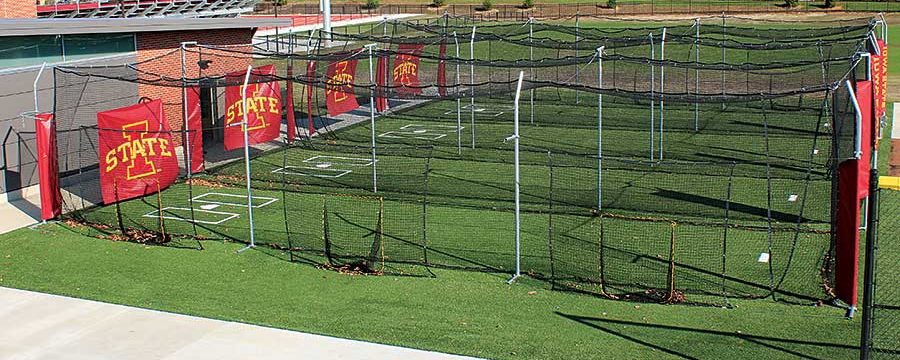Though not an on-field amenity, batting cages are an important part of any ballfield. From location to maintenance, here are the most important considerations to effectively incorporate batting cages into your ballfied.
Batting cage location.
 How the cages will be used and safety are the most important factors. For multi-field sites, consider these points:
How the cages will be used and safety are the most important factors. For multi-field sites, consider these points:
- Orient your batting cage north-to-south to prevent the sun from blinding hitters and pitchers during batting practice.
- When placing two or more batting cages in any one area, consider the safety risk of dozens of players and coaches swinging bats in a small area.
- Always install batting cages a minimum of 4′ away from any potential snag points like chain link fences, tree limbs, etc.
- Consider positioning batting cages around the perimeter of a complex. This location can provide:
- better coaching atmosphere away from parents and distractions.
- increased safety by having swinging bats and thrown balls away from spectators and pedestrians inside the park.
- convenience for coaches hauling practice equipment.
Single or multiple cages.
Having multiple cages side-by-side can save money. However, this can cause problems for competing teams.
- A double cage (side-by-side) is a great setup, but adding more cages (3up, 4up or more) means that there will be a herd of players and coaches stacked on top of one another.
- Coaches and players appreciate not having to warm up next to opponents.
- Consider placing multiple 2-up cages in different parts of your complex.
Batting cage flooring.
There are several options for flooring and the cost of maintenance requirements vary. Below is a list of options and recommendations.
- Natural grass. Not recommended due to constant mowing and trimming. This increases the risk of damage to netting. Additionally, grass wears way too quickly.
- Infield mix/clay. Not recommended due to intense maintenance and slow recovery after rain.
- Crushed aggregate. A low-cost option that requires regular maintenance (raking/leveling). Use crushed stone fines (3/16″ minus) for best results. Installing fortification (Jox Box, Porous Rubber BB Mats, etc.) in batters’ area is highly recommended for best footing. This surface will scuff up practice balls due to abrasiveness.
- Artificial turf over aggregate base. A medium-cost option. This surface requires a perimeter nailer board to be installed at ground level to anchor the turf. To prevent movement of the aggregate base, it is highly recommended that a solid fortification be installed underneath the turf in the batters’ area. This will prevent low areas from developing. Always use a hitting mat on top of the permanent turf in order to extend the life of the turf around the plate.
- Bare concrete or asphalt. A high-cost option but low-cost maintenance. Ricochet off the hard surface means players must use extreme caution. The abrasive surface will quickly scuff up practice balls.
- Artificial turf over concrete or asphalt. The highest-cost option with low maintenance requirements It requires professional installation of both the concrete and turf to ensure proper glue-down. Always use hitting mats at the plate to prevent the permanent turf from wearing prematurely at the batter’s boxes.
Padded backings on artificial turf are a considerable cost without providing significant benefit in terms of durability. They also absorb and hold water in outdoor applications and can negatively impact the life of the turf. Consider instead a better quality (higher density) turf product with a greater face weight to achieve the best cushioned feel. This turf will last longer and dry out more easily.
If an infilled turf is used (filled with crumb rubber, sand, or some other filler product), create a containment curb around the perimeter of your turf installation. This will reduce any migration of the infill. If the material piles along the edge, redistribute it around the floor of the cage and broom it back in to the fibers. The infill will help the fibers stand upright and will slow the fiber’s wear.

When to use ground sleeves.
Consider using ground sleeves for your poles when…
![]() How the cages will be used and safety are the most important factors. For multi-field sites, consider these points:
How the cages will be used and safety are the most important factors. For multi-field sites, consider these points:

 . . . . . . . . . . . . . . . . . . . . . . . . . . . . . . . . . . . .
. . . . . . . . . . . . . . . . . . . . . . . . . . . . . . . . . . . .
0 Comments